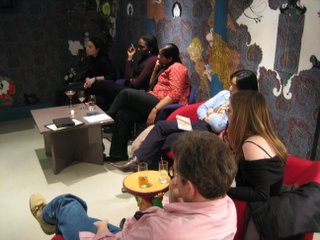ORGANISATION, STRATEGY & DESIGN : SHIFTS SIDEWAYS : 12.12.05
 Organisation, strategy and design shifted sideways for a delicious Christmas outing,12.12.05.
Organisation, strategy and design shifted sideways for a delicious Christmas outing,12.12.05. Set against crafted, paint-licked wallpaper David Barrie peeled apart his C4 project in the northern town of Castleford. The project, propelled by the icky power of telly, collides the revealing process of documentary with an urge for actually realising change in the urban realm.
Castleford is part of a trickle of a ‘pool of nothingness’ across ex-mining towns in the north, indicative of a series of places whose civic spaces have been absorbed back into the ground. From rotting playgrounds to inaccessible monuments parked in the middle of roundabouts, a withdrawal of investment by companies and government has instigated a lack of trust and ownership by local people. David uses the C4 link gently and aggressively in turns to ‘mercilessly engage people’, to empower them to instigate and take ownership of new public places.
To initiate the process Barrie’s team, acting as a separate vehicle to the camera crew, set up action quarters in an ex furniture shop on the high road. This newly white and delicate open access place acted as an icon to being bothered and reinforced that the project could make a physical difference. An extensive program of consultation enabled local people to directly choose their architects and designers (simple but daring, this never usually happens).
Citing active members of the community as lynchpins, Barrie also supported small ventures, instigating the creation of more communities of interest through offering a vouch from the media to help funding applications get taken seriously both by the groups applying and the funders.

Barrie is audacious. In this project he plays the role of the contemporary architect- the instigator, the one who will be organised enough, persuasive and dogged enough to effect change. And those of us who are trained as architects or planners, urban maestros or public artists, can ask how does this media guy so tremendously infiltrate and lift multiple communities? Will its effects on public place last? Will the communities of interest provoked persist? Media provides a magnetic inroad- it's a verification of cause, as effective on kick starting an urban project as a nativity play.
Taking Barrie’s project as a launchpad, could media involvement encourage councils to communicate with each other? Could shared knowledge between towns and cities in the north struggling with the same problems (Bradford through Burnley to Liverpool) assist projects to exist as a chain, rather than disparate, competitive ventures? These are government funding issues, the introduction of CABE promises more and more projects that flirt with 2% of the budget on developer missions. Developers are forced to cut a slice of their profit into consulting with the community. That's not enough, public space should not be a sideline concern, a political attitude shift is needed. We are all entitled to good public space.
Hats off to David.
Written by Suzi Winstanley





 subscribe to our feed
subscribe to our feed
<< Home